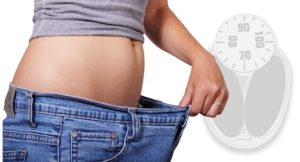When most people think of tracking their weight loss goals, they envision standing on a scale. While this method can definitely be used to monitor the amount of weight lost, it fails to tell you whether you are losing fat, muscle, or both. Since many people choose to lose weight as a way of being healthier, it is important to keep track of several factors such as weight loss, nutrition, exercise, and overall health. In order to keep track of these various factors, your nutritionist will recommend a DEXA scan.
You may have heard of a DEXA scan before, especially if you have ever been tested for or diagnosed with osteoporosis. This is because DEXA scans are used to quantify bone mass. However, DEXA scans are also used to quantify body fat, as well as to provide information on regional measures of fat mass and lean mass. Simply stated, a DEXA scan will tell you how much of your weight is fat, muscle, or bone.
DEXA scans are also more precise than other popular weight tracking methods such as:
BMI: Body mass index uses weight and height to determine excess weight. However, BMI can be affected by factors such as age, sex, ethnicity, and muscle mass. Ultimately, BMI only measures excess weight, rather than excess body fat.
InBody: based on bioelectrical impedance analysis (BIA), which measures electrical currents that move through the body to determine the resistance. Since most water is stored in the muscle, low levels of resistance indicate more muscle. However, this technique can be affected by dehydration or recent meals. Its level of accuracy has also been called into question.
BodPod: An egg-shaped pod that you sit in which measures your weight and volume to determine the percentage of body fat present. It works by using air displacement plethysmography. While BodPod is considered to be one of the more accurate methods, its results can be affected by the type of clothing worn during the test.
Hydrostatic Weighing: The body is weighed on land, and then submerged into water, and weighed again after all the air has been pushed out of the lungs. The difference between these two weights is used to calculate fat percentage. However, this method is not commonly used due to its lack of convenience.
What does DEXA mean?
DEXA stands for dual-energy x-ray absorptiometry. It works by emitting two low-dose x-rays that are approximately 10% of the radiation used in a standard chest x-ray. The tissues in the body absorb these x-rays differently, creating a unique density profile. This information is then used to determine how dense the type of tissue (ex. fat, muscle, or bone) is.
Not only does information from a DEXA scan determine your body density in terms of fat, muscle, and bone, but it also pinpoints where these tissues reside. Knowing where the majority of your fat tissue resides can help you and your nutritionist develop a diet and exercise plan that targets these specific areas.
Having multiple DEXA scans is also beneficial to track your progress. Unfortunately, it can be discouraging to step on the scale and see that you haven’t lost weight or even that you have gained weight. However, having a DEXA scan may show that this is due to the fact that you have gained muscle or bone mass, rather than fat. Ultimately by providing in-depth information about your body composition, DEXA scans can be used to help you decrease your fat, increase your muscle, and achieve a higher level of overall health.




